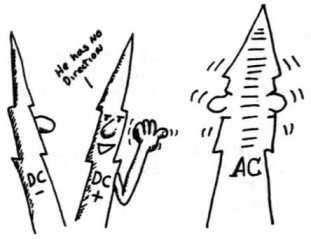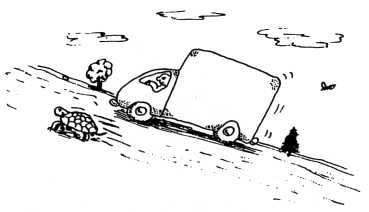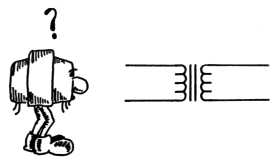
Speaking of blowing things up, I once had a crazy friend who owned a large variable power transformer. He would take an assortment of components and place them on a big flat rock in his back yard, where we could see them through the safety of his bedroom window. The components were then connected to the power transformer with a long heavy wire. Now this particular transformer could put out any voltage between zero and 240 volts, which was derived from being plugged into the wall outlet. Of course, the whole point was to start with a small amount of voltage, and then gradually increase it until the components blew up. I'll put it this way: a lot of juice was sent down that wire, and we had quite a bit of fun.

But what does that have to do with this tutorial? Nothing
at all -- it's just a good story! Seriously, though, the purpose of a
transformer is to convert voltages either up or down, but it only works with AC
current. Though a transformer is more like an inductor than a capacitor, it uses
magnetism to allow the electricity to pass between wires that aren't connected.
Let's take a closer look.
Transformers use a principle known as magnetic induction, and they operate much like the transmission in an automobile. If you've ever watched Mr. Wizard on TV, you've surely seen an electromagnet. Unlike the permanent magnets that some people stick on their refrigerator, an electromagnet consists of a coil of wire wound around a piece of iron or steel. When an electric current is applied to the ends of the wire, the iron core becomes magnetized. And when the electricity is removed the magnetism disappears.
It should come as no surprise that the exact opposite holds true as well -- if you magnetize the iron, then electricity will be developed in the wire. In fact, this is how electric generators in a power plant work. But in order for a voltage to be produced, the magnetism must be constantly changing. That is, putting a coil of wire over a permanent magnet won't do a thing, except for the instant it's first put into place.
A transformer, therefore, requires AC to operate, and it
is made up of two coils of wire wrapped around a single piece of iron. When a
constantly alternating voltage is applied to one of the wires the iron will
become magnetized, though the magnet's polarity (North/South) will also change
constantly. And while one of the coils is creating the magnetism, the other will
respond by generating electricity from it. But what does this have to do with an
auto transmission?
In a transmission, gears are used to vary the speed of your car, though at the expense of apparent power. That is, for a given amount of horsepower, you can either go slowly but with the ability to climb a steep hill, or go much faster as long as you stick to level terrain. Remember, the power doesn't really vary when you change gears, only the way that power is used. Nothing comes for free, and the transmission merely changes the way an engine's power is distributed.
In an identical manner, a transformer can transform a
voltage that is applied to one of the wires, to produce a higher or lower
voltage in the other. The key point here is the ratio between the number of
windings in each coil. If one of the coils consists of 200 turns of wire, and
the other has only 100, then the ratio between them will be two to one. And if
you put ten volts into the larger coil, only five volts will appear in the
smaller one, though the available current will be twice as much. The actual
power always stays the same, and it's just the distribution that really changes.
By the way, even when a circuit could operate on 115 volts directly, a transformer is often used just for safety. The very fact that the two windings are not really connected provides some degree of protection against being electrocuted.